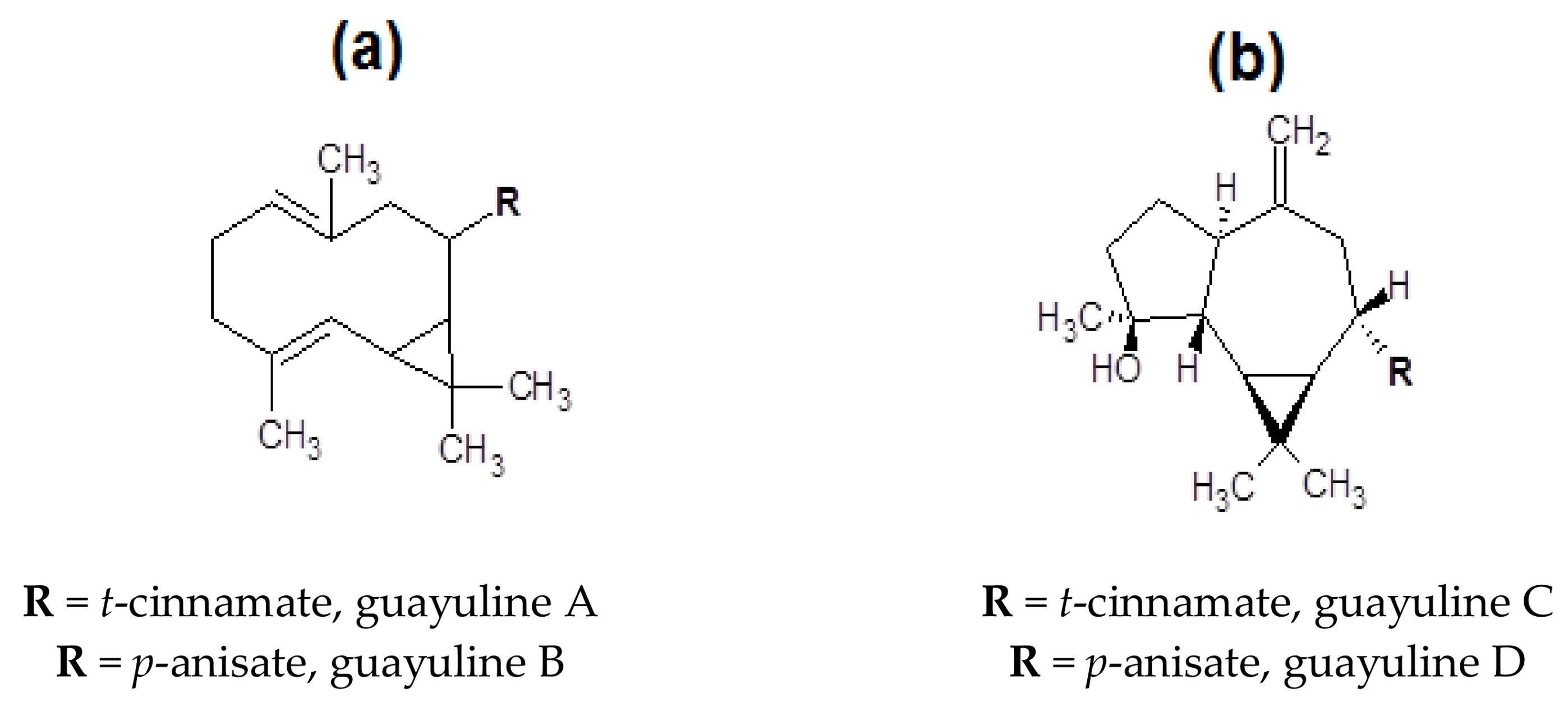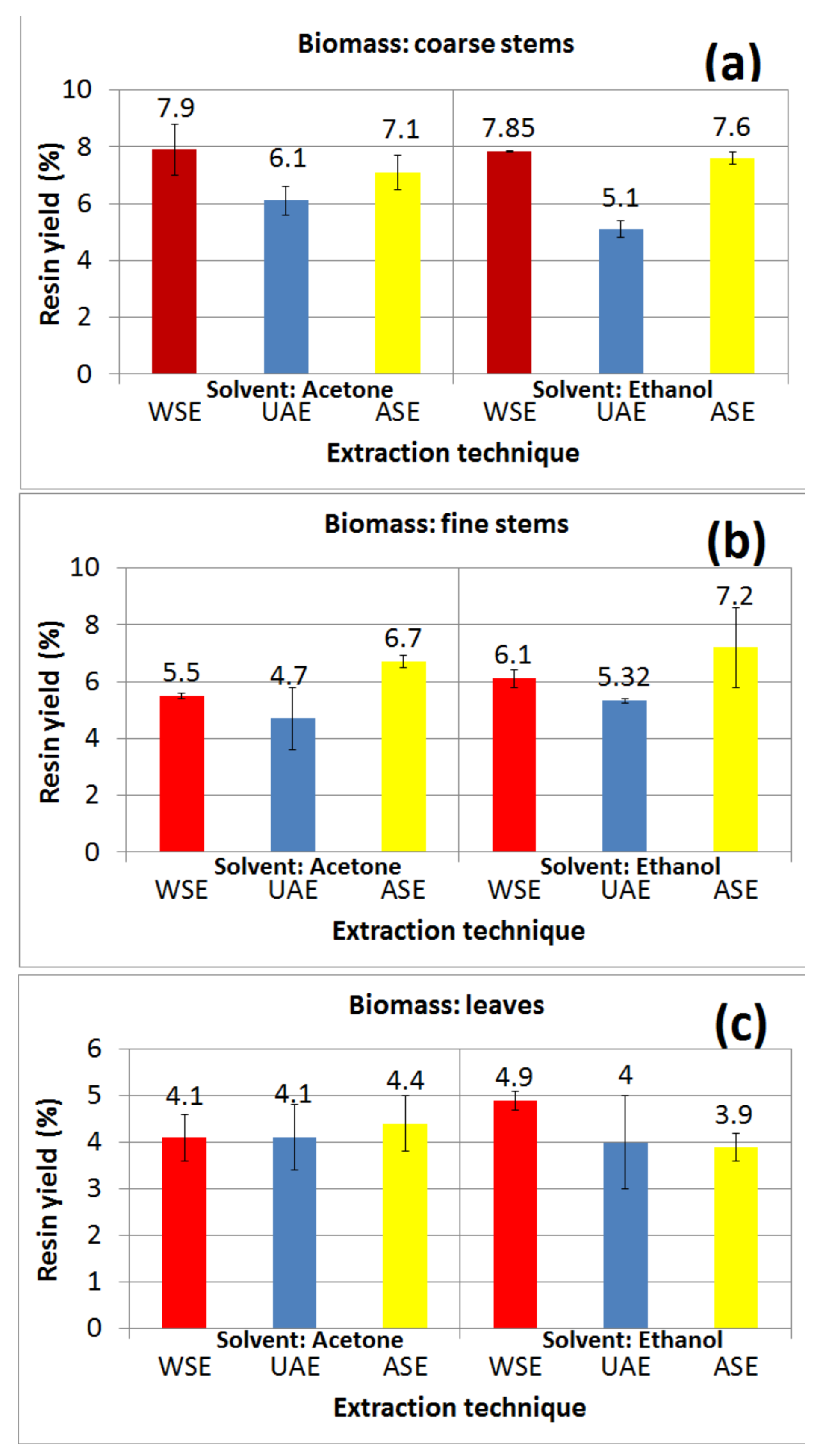Assessment, Validation and Application to Real Samples of an RP-HPLC Method for the Determination of Guayulins A, B, C and D in Guayule Shrub
Abstract
:1. Introduction
2. Materials and Methods
2.1. Samples and Sample Preparation
2.2. Chemicals and Reagents
2.3. Instrumentation
2.4. Validation
3. Results
3.1. Choice of the Extraction Procedure
3.1.1. Procedures of Extraction
Extraction with Warm Solvents (WSE)
Ultrasonic Assisted Extraction (UAE)
Accelerated Solvent Extraction (ASE)
3.2. Assessment of the Chromatographic Method
3.3. Analysis of the Resin Extracts
3.4. Validation
3.5. Application on Real Samples
3.5.1. Guayulins in Guayule Leaves
3.5.2. Guayulins in Guayule Stems
4. Conclusions
Acknowledgments
Author Contributions
Conflicts of Interest
References
- McIntyre, D.; Stephens, H.L.; Schloman, W.W., Jr.; Bhowmick, A.K. Guayule rubber. In Handbook of Elastomers, 2nd ed.; Bhowmick, A.K., Stephens, H., Eds.; CRC Press: Boca Raton, FL, USA, 2000; ISBN 9780824703837. [Google Scholar]
- Van Beilen, J.B.; Poirier, Y. Establishment of new crops for the production of natural rubber. Trends Biotechnol. 2007, 25, 522–529. [Google Scholar] [CrossRef] [PubMed]
- Van Beilen, J.B.; Poirier, Y. Guayule and Russian Dandelion as Alternative Sources of Natural Rubber. Crit. Rev. Biotechnol. 2007, 27, 217–231. [Google Scholar] [CrossRef] [PubMed]
- Schloman, W.W., Jr.; Garrot, D.J., Jr.; Ray, D.T.; Bennett, D.J. Seasonal Effects on Guayule Resin Composition. J. Agric. Food Chem. 1986, 34, 177–179. [Google Scholar] [CrossRef]
- Eagle, F.A. Guayule. Rubber Chem. Technol. 1981, 54, 662–684. [Google Scholar] [CrossRef]
- Schloman, W.W., Jr.; Hively, R.A.; Krishen, A.; Andrews, A.M. Guayule Byproduct Evaluation: Extract Characterization. J. Agric. Food Chem. 1983, 31, 873–876. [Google Scholar] [CrossRef]
- Romo, J.; Romo De Vivar, A.; Ortega, A.; Diaz, E. Guayulins A and B, new sesquiterpenes isolated from guayule. Rev. Latinam. Quim. 1970, 1, 132–135. [Google Scholar]
- Martinez, M.; Flores, G.; Romo de Vivar, A.; Reynolds, G.; Rodriguez, E. Guayulins C and D from Guayule (Parthenium Argentatum). J. Nat. Prod. 1986, 49, 1102–1103. [Google Scholar] [CrossRef] [PubMed]
- Watkins, S.F.; Fronczek, F.R.; Chiari, G.; Reynolds, G.W.; Rodriguez, E. Molecular structure of guayulin A. J. Nat. Prod. 1985, 48, 631–633. [Google Scholar] [CrossRef] [PubMed]
- Sidhu, O.P.; Ratti, N.; Behl, H.M. Quantitative and Qualitative Variations in Resin Content and Guayulins (A and B) among Different Guayule Cultivars. J. Agric. Food Chem. 1995, 43, 2012–2015. [Google Scholar] [CrossRef]
- Teetor, V.H.; Ray, D.T.; Schloman, W.W., Jr. Evaluating chemical indices of guayule rubber content: Guayulins A and B. Ind. Crop. Prod. 2009, 29, 590–598. [Google Scholar] [CrossRef]
- Mau, C.; Cornish, K. Guayule Plants, Products, and Derivatives. US Patent 8013213, 6 September 2011. [Google Scholar]
- Mohan Behl, H.; Marchand, B.; Rodriguez, E. Inheritance of Sesquiterpenoid Phenolic Acid Esters (Guayulins) in F1 Hybrids of Parthenium (Asteraceae). Z. Naturforsch. 1983, 38, 494–496. [Google Scholar] [CrossRef]
- Rodriguez, E.; Towers, G.H.N.; Mitchell, J.C. Biological activities of sesquiterpene lactones. Phytochemistry 1976, 15, 1573–1580. [Google Scholar] [CrossRef]
- Rodriguez, E.; Reynolds, G.W.; Thompson, J.A. Potent Contact Allergen in the Rubber Plant Guayule (Parthenium argentatum). Science 1981, 211, 1444–1445. [Google Scholar] [CrossRef] [PubMed]
- Cornish, K.; Williams, J.L.; Kirk, M.; Teetor, V.H. Evaluation & control of potential sensitizing & irritating chemical components in natural rubber latex extracted from the industrial crop guayule. Ind. Biotechnol. 2009, 5, 245–252. [Google Scholar] [CrossRef]
- Coffelt, T.A.; Nakayama, F.S.; Ray, D.T.; Cornish, K.; McMahan, C.M. Post-harvest storage effects on guayule latex, rubber, and resin contents and yields. Ind. Crop. Prod. 2009, 29, 326–335. [Google Scholar] [CrossRef]
- Proksch, P.; Mohan Behl, H.; Rodriguez, E. Detection and quantification of guayulins A and B in Parthenium argentaturn (guayule) and F1 hybrids by high-performance liquid chromatography. J. Chromatogr. A 1981, 213, 345–348. [Google Scholar] [CrossRef]
- Ray, D.T.; Veatch-Blohm, M.E.; Teetor, V.H.; Walsh, B. Upper and Lower Heritability Estimates in Guayule Based on Mode of Reproduction. J. Am. Soc. Hort. Sci. 2007, 132, 213–218. [Google Scholar]
- Lloyd, F.E. Guayule (Parthenium Argentatum Gray), a Rubber Plant of the Chihuahuan Desert; Carnegie Institution of Washington: Washington, DC, USA, 1911; pp. 57–58. [Google Scholar]
- Norma Oficial Mexicana NOM-007-RECNAT-1997. Procedimientos, Criterios y Especificaciones Para Realizar el Aprovechamiento, Transporte y Almacenamiento de Ramas, Hojas o Pencas, Flores, Frutos y Semillas; Diario Oficial de la Federaciòn de los Estados Unidos Mexicanos: Ciudad de Mexico, Mexico, 1997.
- Mocak, J.; Bond, A.M.; Mitchell, S.; Schollary, G. A statistical overview of standard (IUPAC and ACS) and new procedures for determining the limits of detection and quantification: Application to voltammetric and stripping techniques. Pure Appl. Chem. 1997, 69, 297–328. [Google Scholar] [CrossRef]
- Horwitz, W. Evaluation of analytical methods used for regulation of foods and drugs. Anal. Chem. 1982, 54, 67A–76A. [Google Scholar] [CrossRef]
- AOAC International. AOAC Peer Verified Methods Programs, Manual on Policies and Procedures; AOAC International: Arlington, VA, USA, 1998. [Google Scholar]
- Salvucci, M.E.; Coffelt, T.A.; Cornish, K. Improved methods for extraction and quantification of resin and rubber from guayule. Ind. Crop. Prod. 2009, 30, 9–16. [Google Scholar] [CrossRef]
- Yeom, H.; Suh, J.H.; Youm, J.R.; Han, S.B. Simultaneous Determination of Triterpenoid Saponins from Pulsatilla koreana using High Performance Liquid Chromatography Coupled with a Charged Aerosol Detector (HPLC-CAD). Bull. Korean. Chem. Soc. 2010, 31, 1159–1164. [Google Scholar] [CrossRef]



| Stationary Phase (mm × mm × μm) | Mobile Phase (v:v) | Flow Rate (mL min−1) | λ of Quantification (nm) | Guayulins Quantified | Reference |
|---|---|---|---|---|---|
| MicroPak MCH-10 (300 × 4.6 × 10) | from CH3CN:H2O 50:50 to CH3CN:H2O 75:25 | n.r. | 262 | A and B 1 | [6] |
| C18 column 2 | MeOH:H2O gradient elution 2 | n.r. | 215 | C and D | [8] |
| RP-C18 column 2 | MeOH:H2O 89:11 | 1 | 254 | A and B | [10] |
| Microsorb-MV (250 × 4.6 × 5) | from CH3CN:H2O 80:20 to pure CH3CN | 1.5 | 262 | A and B 3 | [11,16,17,19] |
| Altex Ultrasphere ODS type (150 × 4.6 × 5) | MeOH:H2O 93:7 | 1 | 254 | A and B | [13] |
| Lichrosorb RP-18 (250 × 4.6 × 10) | CH3CN:H2O 75:25 | 2.5 | 254 | A and B | [18] |
| Stationary Phase (Length, mm × Diameter, mm × Particle Size, μm) | Ascentis® C18 (250 × 4.6 × 5) |
|---|---|
| Mobile phase (v:v) | CH3CN:H2O 80:20 |
| Elution mode | Isocratic |
| Volume (µL) | 20 |
| Flux of mobile phase (mL min−1) | 1.5 |
| UV wavelength (nm) | 262 |
| Column temperature (°C) | 25 |
| Length of the chromatographic run (min) | 25 |
| Guayulin | Sensitivity (n = 3) | Linearity | Repeatability (n = 5) | Intermediate Precision (n = 5) | Bias (n = 2) | |||||
|---|---|---|---|---|---|---|---|---|---|---|
| LoD (mg L−1) | LoQ (mg L−1) | Concentration Range (mg L−1) | R2 | CVexp,r a | HorRatr b | CVexp,IP c | HorRatexp,IP d | Recovery (% ± SD e) on Acetone | Recovery (% ± SD e) on Ethanol | |
| A | 0.032 ± 0.004 | 0.10 ± 0.01 | 0.2–500 | 0.9994 | 1.3 | 0.26 | 3.2 | 0.43 | 87 ± 4 | 89 ± 6 |
| B | 0.051 ± 0.004 | 0.15 ± 0.01 | 0.2–250 | 0.9991 | 1.7 | 0.29 | 3.5 | 0.41 | 91 ± 2 | 88 ± 8 |
| C | 0.034 ± 0.009 | 0.10 ± 0.03 | 0.1–200 | 0.9989 | 1.5 | 0.58 | 4.0 | 0.39 | 81 ± 9 | 80 ± 10 |
| D | 0.055 ± 0.005 | 0.16 ± 0.02 | 0.16–200 | 0.9984 | 3.6 | 0.39 | 10 | 0.26 | 73 ± 5 | 77 ± 8 |
| Guayulins (mg kg−1 ± SD) | ||||||||
|---|---|---|---|---|---|---|---|---|
| Sample (Solvent) | A (A) | A (E) | B (A) | B (E) | C (A) | C (E) | D (A) | D (E) |
| L1 | 2080 ± 40 a | 2140 ± 40 a | 444 ± 9 a | 449 ± 4 a | 1638 ± 8 a | 1400 ± 45 b | 360 ± 30 a | 330 ± 30 a |
| L2 | 2030 ± 65 a | 2190 ± 20 a | 428 ± 6 a | 460 ± 9 a | 1650 ± 7 a | 1560 ± 45 b | 370 ± 20 a | 330 ± 20 a |
| FS1 | 3810 ± 30 a | 3230 ± 40 a | 615 ± 9 a | 500 ± 20 a | 372 ± 6 a | 204 ± 4 a | 8.4 ± 0.7 c | 6.52 ± 0.07 a |
| FS2 | 4190 ± 40 a | 3640 ± 10 a | 1190 ± 20 a | 1150 ± 9 a | 61.5 ± 0.1 a | 26.4 ± 0.7 a | <0.32 * | <0.32 * |
| CS1 | 8160 ± 90 a | 9830 ± 20 a | 700 ± 10 d | 884.8 ± 0.7 a | 1010 ± 4 a | 1044 ± 7 a | 25 ± 2 a | 55 ± 2 a |
| CS2 | 8800 ± 100 a | 7800 ± 100 a | 3090 ± 20 a | 2810 ± 40 a | 249 ± 4 a | 199 ± 4 a | 23 ± 2 a | 16 ± 2 a |
© 2018 by the authors. Licensee MDPI, Basel, Switzerland. This article is an open access article distributed under the terms and conditions of the Creative Commons Attribution (CC BY) license (http://creativecommons.org/licenses/by/4.0/).
Share and Cite
Spano, N.; Meloni, P.; Idda, I.; Mariani, A.; Pilo, M.I.; Nurchi, V.M.; Lachowicz, J.I.; Rivera, E.; Orona-Espino, A.; Sanna, G. Assessment, Validation and Application to Real Samples of an RP-HPLC Method for the Determination of Guayulins A, B, C and D in Guayule Shrub. Separations 2018, 5, 23. https://doi.org/10.3390/separations5020023
Spano N, Meloni P, Idda I, Mariani A, Pilo MI, Nurchi VM, Lachowicz JI, Rivera E, Orona-Espino A, Sanna G. Assessment, Validation and Application to Real Samples of an RP-HPLC Method for the Determination of Guayulins A, B, C and D in Guayule Shrub. Separations. 2018; 5(2):23. https://doi.org/10.3390/separations5020023
Chicago/Turabian StyleSpano, Nadia, Paola Meloni, Ilenia Idda, Alberto Mariani, Maria Itria Pilo, Valeria Marina Nurchi, Joanna Izabela Lachowicz, Ernesto Rivera, Ancelmo Orona-Espino, and Gavino Sanna. 2018. "Assessment, Validation and Application to Real Samples of an RP-HPLC Method for the Determination of Guayulins A, B, C and D in Guayule Shrub" Separations 5, no. 2: 23. https://doi.org/10.3390/separations5020023






